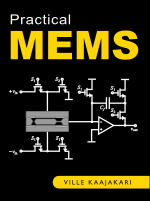Introduction
Piezoelectric materials can produce large forces but only small displacements. Hence they scale favorably when devices are miniaturized to a micron scale. Unfortunately piezoelectric materials require special processing that is not always available or compatible with other processes used to make micromachines. Hence other actuation methods such as electrostatic actuation have received more attention.
 Our approach at
the
SonicMEMS group has been to use bulk piezoelectric plates mounted
at the back of a silicon die to actuate surface micromachines. There
is a major advantage in this: no special processing is required and
the method is suitable for micromachines from any process. Another
advantage is that no valuable die surface area is consumed. The GIF
graphics below illustrates the idea. The piezoelectric plate generates
a vibrations and/or pulses that travels to the surface of the
die. These vibrations and pulses can be used to release stuck
micromachines and
actuate other micromachines. This work has been patented, and for
licensing you can contact the
Wisconsin Alumni Research Foundation.
Our approach at
the
SonicMEMS group has been to use bulk piezoelectric plates mounted
at the back of a silicon die to actuate surface micromachines. There
is a major advantage in this: no special processing is required and
the method is suitable for micromachines from any process. Another
advantage is that no valuable die surface area is consumed. The GIF
graphics below illustrates the idea. The piezoelectric plate generates
a vibrations and/or pulses that travels to the surface of the
die. These vibrations and pulses can be used to release stuck
micromachines and
actuate other micromachines. This work has been patented, and for
licensing you can contact the
Wisconsin Alumni Research Foundation.
Release
 Another application is to release
stuck
micromachines. When devices
are scaled down, their surface to volume ratio increases. As a result
even working micromachines can get stuck if they come in contact with
another micromachine or surface of the substrate. Considerable effort
has been put into finding suitable coatings to solve this
problem. Unfortunately these coatings can wear and leave micromachines
without protection. Using stress pulses we successfully released stuck
micromachined beams. This is demonstrated in the animation below. We
believe this method can increase the reliability of micromachines.
Another application is to release
stuck
micromachines. When devices
are scaled down, their surface to volume ratio increases. As a result
even working micromachines can get stuck if they come in contact with
another micromachine or surface of the substrate. Considerable effort
has been put into finding suitable coatings to solve this
problem. Unfortunately these coatings can wear and leave micromachines
without protection. Using stress pulses we successfully released stuck
micromachined beams. This is demonstrated in the animation below. We
believe this method can increase the reliability of micromachines.
Assembly
 We have
successfully raised micromachined flaps using the pulsing
technique. Because micromachines have very small mass, gravity has
negligible effect on them. Raised beams remain up even after pulsing
has ended. This can be compared to balancing a card on its side in the
"macro world". Drag force, however, cannot be neglected: in
atmospheric pressure the flaps hardly move and the raising must be
done in a vacuum. This is one example of how forces scale sometimes
unintuitively to the micron scale.
We have
successfully raised micromachined flaps using the pulsing
technique. Because micromachines have very small mass, gravity has
negligible effect on them. Raised beams remain up even after pulsing
has ended. This can be compared to balancing a card on its side in the
"macro world". Drag force, however, cannot be neglected: in
atmospheric pressure the flaps hardly move and the raising must be
done in a vacuum. This is one example of how forces scale sometimes
unintuitively to the micron scale.
One possible application is parallel assembly of micromachines. Although micromachine fabrication is typically a parallel process, the assembly requires series processing. The cost associated with this can be prohibitive. A SEM of a fully assembled micromachined flap structures is shown below.

Microengine
 We have shown the
first ever completely
surface micromachined ultrasonic rotor. It operates with a
single-phase drive, which is different than the many electrodes needed
for traditional ultrasonic motors. Driving voltages as low as 4 Vpp
has been demonstrated which makes integration with standard CMOS
technology feasible. This voltage is very low compared to
electrostatic micromotors that typically need around 100 volts to
operate. Thermal actuators work with low voltages but compared to
ultrasonic actation they require large currents. A complete microengine
with 50:7 gear ratio shown in GIF animation below has been
demonstrated suggesting high torque capabilities. The motor was
operated continously for four days and no problems were observed. The
direction of rotation can be controlled by adjusting the drive
frequency.
We have shown the
first ever completely
surface micromachined ultrasonic rotor. It operates with a
single-phase drive, which is different than the many electrodes needed
for traditional ultrasonic motors. Driving voltages as low as 4 Vpp
has been demonstrated which makes integration with standard CMOS
technology feasible. This voltage is very low compared to
electrostatic micromotors that typically need around 100 volts to
operate. Thermal actuators work with low voltages but compared to
ultrasonic actation they require large currents. A complete microengine
with 50:7 gear ratio shown in GIF animation below has been
demonstrated suggesting high torque capabilities. The motor was
operated continously for four days and no problems were observed. The
direction of rotation can be controlled by adjusting the drive
frequency.

About this page
This page represents some of the work I did while I was a graduate student at the University of Wisconsin-Madison. My adviser, Prof. Amit Lal, has since moved to Cornell University. If you find this work interesting, you may also want to visit his pages.
